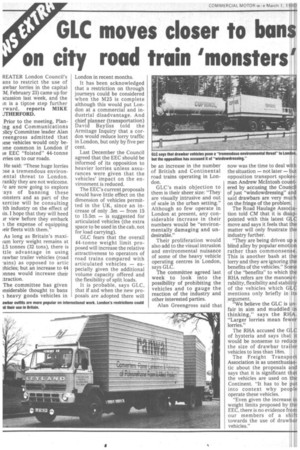GLC moves closer to bans on city road train 'monsters'
Page 26

If you've noticed an error in this article please click here to report it so we can fix it.
REATER London Council's ans to restrict the use of awbar lorries in the capital, 'M, February 23) came up for ;cussion last week, and the Ln is a tiptoe step further rward, reports MIKE jTHERFORD.
Prior to the meeting, Planing and Communications 3licy Committee leader Alan reengross admitted that iese vehicles would only be>tne common in London if le EEC "'foisted" 44-tonne rries on to our roads.
He said: "These huge lorries pse a tremendous environ,ental threat to London. rankly they are not welcome, Te are now going to explore .ays of banning these ionsters and as part of the Ke re is e will be consulting ith industry on the effect of Lis. I hope that they will heed Ir view before they embark the expense of equipping reir fleets with them," As long as Britain's maxiturn lorry weight remains at 2..5 tonnes (32 tons), there is We advantage in using rawbar trailer vehicles (road ains) as opposed to artic ..hicles; but an increase to 44 mnes would increase their :traction.
The committee has given onsiderable thought to bans 1 heavy goods vehicles in London in recent months.
It has been acknowledged that a restriction on through journeys could be considered when the M25 is complete although this would put London at a commercial and industrial disadvantage. And chief planner (transportation) David Bayliss told the Armitage Inquiry that a cordon would reduce lorry traffic in London, but only by five per cent.
Last December the Council agreed that the EEC should be informed of its opposition to heavier lorries unless assurances were given that the vehicles' impact on the environment is reduced.
The EEC's current proposals would have little effect on the dimension of vehicles permitted in the UK, since an increase of only .5m — from 15 to 15.5m — is suggested for articulated vehicles (the extra space to be used in the cab, not for load carrying).
GLC fears that the overall 44-tonne weight limit proposed will increase the relative attractiveness to operators of road trains compared with articulated vehicles — especially given the additional volume capacity offered and the flexibility of split loads.
It is probable, says GLC, that if and when the new proposals are adopted there will be an increase in the number of British and Continental road trains operating in London.
GLC's main objection to them is their sheer size: "They are visually intrusive and out of scale in the urban setting." Although so few operate in London at present, any considerable increase in their numbers would be "environmentally damaging and undesirable."
Their proliferation would also add to the visual intrusion and environmental nuisance of some of the heavy vehicle operating centres in London, says GLC.
The committee agreed last week to look into the possibility of prohibiting the vehicles and to gauge the reaction of the industry and other interested parties.
Alan Greengross said that now was the time to deal with the situation — not later — but opposition transport spokesman Andrew McIntosh countered by accusing the Council of just "windowdressing" and said drawbars are very much on the fringe of the problem.
The Road Haulage Association told CM that it is disappointed with this latest GLC move and says it feels that the matter will only frustrate the industry further.
"They are being driven up a blind alley by popular emotion rather than commonsense. This is another bash at the lorry and they are ignoring the benefits of the vehicles." Some of the "benefits" to which the RHA refers are the manoeuvrability, flexibility and stability of the vehicles which GLC mentions only briefly in its argument. "We believe the GLC is unfair in aim and muddled in thinking," says the RHA. "Larger lorries mean fewer lorries."
The RHA accused the GLC of hysteria and says that it would be nonsense to reduce the size of drawbar trailer vehicles to less than 18m.
The Freight Transport Association is as unenthusiastic about the proposals and says that it is significant that the vehicles are used on the Continent. "It has to be put into context why people operate these vehicles.
"Even given the increase in weight limits proposed by the EEC, there is no evidence from our members of a shift towards the use of drawbar vehicles."
















































































































